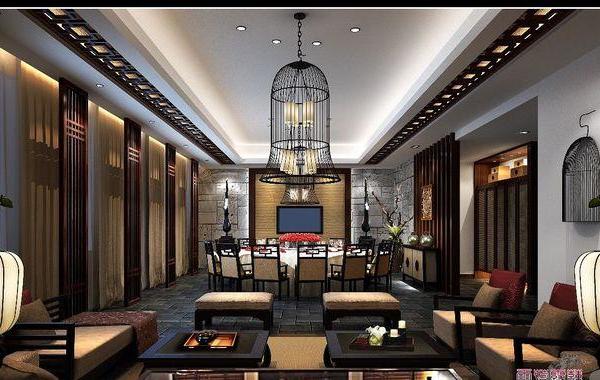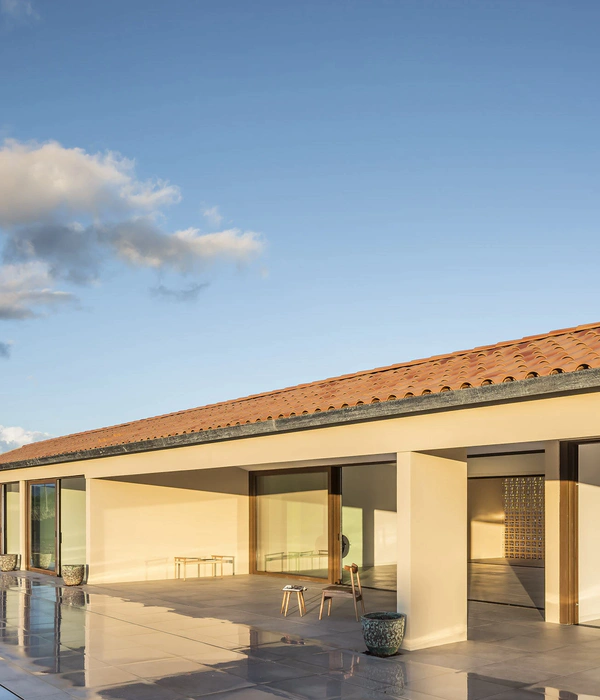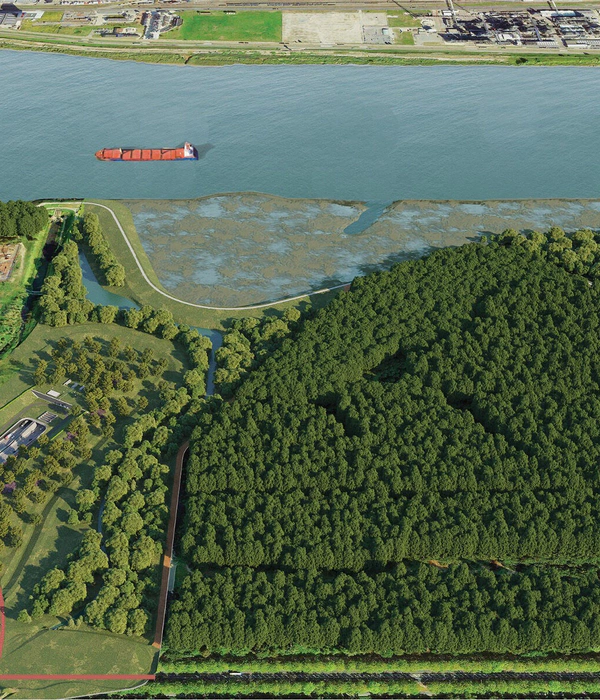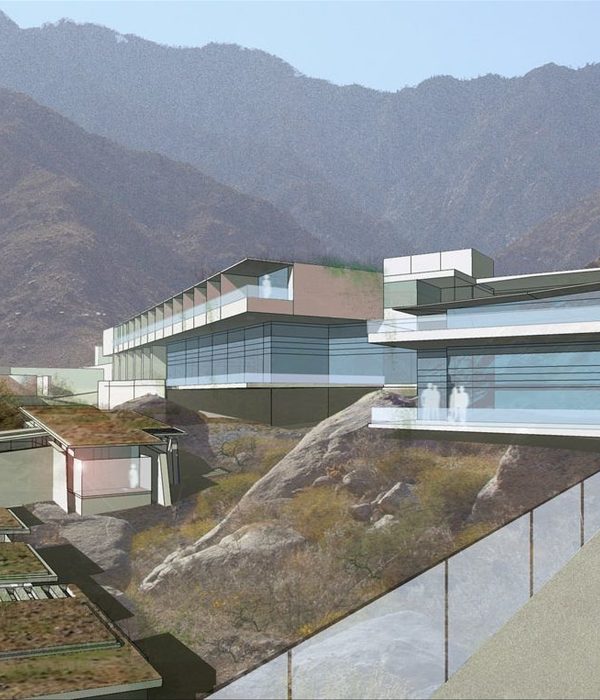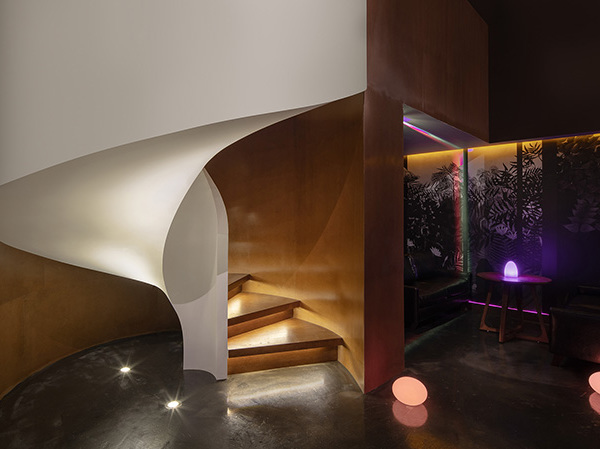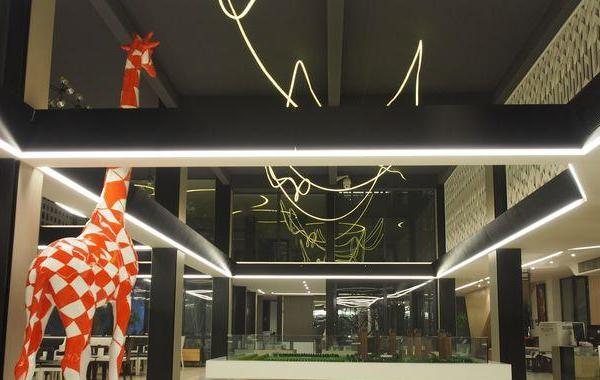St kilda east island villa in Australia
设计方:Clare Cousins Architects
位置:澳大利亚 圣基尔达岛
分类:别墅建筑
内容:实景照片
项目建筑师:Tara Ward, Michael McManus
景观设计师:Fiona Brockhoff Design
图片:18张
摄影师:Shannon McGrath
这是由Clare Cousins Architects设计的圣基尔达岛东别墅。该别墅为新婚夫妇居住,空间充足,然而住宅背后的砖墙隔绝了与宽敞的后院之间的联系。该项目旨在对花园开放,形成连贯的视线通廊,同时形成合力的房间布局,以回应维多利亚时期风格。建筑两翼分别布置生活区和卧室。两者之间布置了餐饮室和庭院,铺设了人字形图案的地板,从而将户外活动引入到别墅中心。庭院的设置,将北部的光线引入室内,并让生活区和卧室提供了直接的视觉联系,尤其是娱乐区和孩子卧室。保留了原有的坡屋顶,新建筑体层高4.5米,晨曦的光线透过玻璃孔撒入厨房。别墅被花园包围,与环境相互融合,尤其是起居室靠窗的座位,能欣赏室内外的风景。
译者: 艾比
Located in St Kilda East, this double fronted Victorian house offered ample space for a young family; however, brick lean-tos at the rear prevented an outlook to the generous back yard. This project opens up the plan to construct layered sight lines to the garden while maintaining a cellular logic of rooms, recalling the Victorian era.
Two wings, established in the original plan, are organised into living and sleeping zones. The threshold space in-between forms a dining room and courtyard, both with a herringbone paved floor, inviting the outdoors into the centre of the house. Introducing northern light deep into the plan, the courtyard permits deliberate visibility between living zones and the sleeping wing, particularly to the play area and bedroom of the client’s only child.The footprint of the new living space occupies that of the original red brick lean-to. Reversing the pitch of the original roof, the new volume soars to a 4.5m high volume punctuated by glass apertures which cast awakening morning light to the kitchen. Surrounded by garden, the house now acknowledges its environment, in particular the living room window seat which draws both the interior and occupant out into the garden.
This double fronted Victorian house offered ample space for a young family; however, brick lean-tos at the rear prevented an outlook to the generous back yard. This project opens up the plan to construct layered sightlines to the garden while maintaining a cellular logic of rooms, recalling the Victorian era.Designed to suit family life, circulation paths are reorganised to enhance a private wing and public wing with sightlines between. Sightlines between their only child’s bedroom and the living area permit visual connectedness between Evie (aged 4) and her parents while utilising different zones of the house.
In contrast to contemporary open plan ‘box-on-the-back’ additions, the project involves a series of additions woven into the fabric of the original building. The majority of the house was retained and restored and the extent of the new works minimised.In order to maintain access to existing garage, the south eastern corner of the existing house could not be extended.Bricks salvaged from the lean-tos are repurposed as the mottled rear facade, a memory of the red and painted structures that they replaced. The slate roof was reinstated at the front restoring the façade to its original condition.
Two wings, established in the original plan, are organised into living and sleeping zones. Spatial planning is driven by the cellular logic of the Victorian house, creating a series of intimate and interconnected spaces. Sliding doors between zones allow the family to open up or close off rooms. Large sliding doors to the rear bedrooms permit play to extend into the corridor and adjacent courtyard.
Nestled between the two wings of the house is the dining room. A threshold space set down with the courtyard both with a herringbone paved floor, inviting the outdoors into the centre of the house.The new plan carefully considers sightlines opening up a strong visual connections through the house and to the garden. The house now acknowledges its environment, in particular from within the living room where the window seat draws both the interior and occupant into the gardenLandscape designer Fiona Brockhoff, a good friend of the owner, created a casual, family friendly landscape with layered perimeter planting to provide privacy and buffer views to and from surrounding buildings. Trees are planted in close proximity to the rear east facing windows providing a layered green outlook and solar protection to glazing.
The majority of the house was retained and restored and the extent of the new works was kept to a minimum. Robust and economical materials are chosen for their familiarity, warmth, and ability to withstand the knocks of family life. Bricks salvaged from the lean-tos are repurposed as the mottled rear facade, a memory of the red and painted structures that they replaced. Materials are selected for their ability to patina with time, often unfinished and requiring minimal maintenance and upkeep. The project was constructed for an average of $2186/m2.
Retaining and restoring the majority of the original period house kept new works to a minimum, allowing for a bigger garden and smaller environmental footprint. Robust and economical materials are chosen for their familiarity, warmth, and ability to withstand the knocks of family life. Bricks salvaged from the lean-tos are repurposed as the mottled rear facade, a memory of the red and painted structures that they replaced. Materials are selected for their ability to patina with time, often unfinished and requiring minimal maintenance and upkeep.
The original house had limited outlook to the rear garden (blocked by lean-tos). The design fosters a greater engagement with the landscape and exterior. The lower ceiling height of the bedroom wing and skylights inject northern light deep into the plan and create new opportunities for passive cross-ventilation.Flexible use of space is encouraged with the inclusion of large sliding doors, enabling rooms to be opened up or closed off, providing flexible use as the family grows or if a new family was to occupy the space.The project incorporates a large rainwater tank for irrigation and toilet flushing, solar hot water, Argon filled double-glazing, LED lighting and bulk insulation retrofitted to original ceiling cavities.
As the front of the original house was in fairly good order, this project aimed to retain and enhance the cellular layout of the original Victorian house. In contrast to contemporary open plan ‘box-on-the-back’ additions, the project involves a series of additions woven into the fabric of the original building. The majority of the house was retained and restored and the extent of the new works minimised.
Slate roof tiles have been reinstated in keeping with the era of the house, replacing metal mock-tile roofing installed in the 1970’s. The discreet extensions are not visible from the street and engage in a materially sympathetic response to the existing heritage fabric. The original brick skin of the house is revealed as an internal material, highlighting the stitching of new to old. The walk in robe and shower is ‘shoe-horned’ into a sliver of land between polychromatic brickwork and a boundary brick wall. Windows and a glazed ceiling immerse the occupants in the outdoors and inject light into the adjacent ensuite, while patterned tiled floors in these spaces reference the tessellated tiles at the Victorian entry.
澳大利亚圣基尔达岛东别墅外部实景图
澳大利亚圣基尔达岛东别墅 外部实景图
澳大利亚圣基尔达岛东别墅背面入口实景图
澳大利亚圣基尔达岛东别墅客厅局部实景图
澳大利亚圣基尔达岛东别墅餐桌实景图
澳大利亚圣基尔达岛东别墅客厅实景图
澳大利亚圣基尔达岛东别墅房间入口实景图
澳大利亚圣基尔达岛东别墅浴室局部实景图
澳大利亚圣基尔达岛东别墅房间实景图
澳大利亚圣基尔达岛东别墅入口实景图
澳大利亚圣基尔达岛东别墅正门入口实景图
澳大利亚圣基尔达岛东别墅平面图
澳大利亚圣基尔达岛东别墅剖面图
澳大利亚圣基尔达岛东别墅分析图
{{item.text_origin}}


